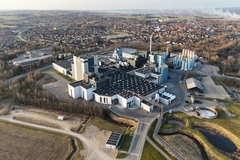
- Industry news
Industry news
- Category news
Category news
- Reports
- Key trends
- Multimedia
Multimedia
- Journal
- Events
- Suppliers
- Home
- Industry news
Industry news
- Category news
Category news
- Reports
- Key trends
- Multimedia
Multimedia
- Events
- Suppliers
New Culture Offers “Considerably Decreased” Fermentation Time for Red Wine

03 Jun 2014 --- A new range of Viniflora products is available to red wine producers, reversing the classical scheme of fermentation management in wines. Viniflora NoVA, by Chr Hansen, offers winemakers the chance to manage their malolactic fermentation in the grape juice before the alcoholic fermentation, which considerably decreases the fermentation time.
The production of red wine requires two steps during the wine making process: The alcoholic fermentation where yeasts transform sugars into ethanol and some flavors, traditionally followed by the malolactic fermentation where lactic acid bacteria transform malic acid into lactic acid and a second layer of fermentation related flavors.
Chr Hansen’s approach with Viniflora NoVA is totally opposite; the company noted that what it now offers to winemakers is to manage their malolactic fermentation in the grape juice before the alcoholic fermentation: “A complete change of paradigm,” the company said.

Speaking to FoodIngredientsFirst, marketing director, wine and fermented beverages, Laurent Hubert explained: “There is absolutely no question mark regarding the regulatory status of Lactobacillus plantarum’s use in winemaking as long as there selection and specifications follow the international standards from the OIV (this is the international organization managing the principles, specifications and guidelines regarding oenological practices and products allowed and we fully comply with the OIV specifications regarding malolactic bacteria for winemaking).”
The benefits for winemakers are that NoVa offers a dramatically reduced fermentation time and risk of spoilage. When the malolactic fermentation happens in grape juice instead of wine the time of this fermentation phase is considerably decreased. Typically with NoVA, malolactic fermentation is managed in one to three days as opposed to three to 12 weeks. The wines go through malolactic and alcoholic fermentation within 10 days and are then microbiologically stable.
Hubert also added that, “‘Grape juice’ is named ‘must’ in winemaking and that’s the ‘raw material to make wine’ that you have after the grape berries are crushed shortly after their harvesting”. NoVA is based on a Lactobacillus plantarum strain that was discovered in a must. Lactobacillus strains are allowed in winemaking as long as they have been isolated from grape berries, grape juice, must or wines (OIV standards), which is fully the case with Viniflora NoVA and all the products of our Viniflora range.”
Chr Hansen has already had a wine product based on a strain of Lactobacillus in the 1990s that was named ‘Viniflora Plantarum’ – developed nearly 15 years ago. “NoVa is very different but both Plantarum and NoVA have in common the species of lactic acid bacteria they are based on,” she said.
Hubert explained that NoVa does have some impact on the development of the wine itself. “By consuming the malic acid extremely early in the process, NoVA avoids the development of contamination flora that may spoil the wine or at least downgrade its flavor profile, producing off-flavors,” she said. “Wines made with NoVA are generally more fruit-forward than wines that have been used as ‘control’ in field trials.”
She continued: “With NoVA winemakers have a tool to reduce contaminations at a very early stage, right into the grape juice, therefore they reduce the impact of spoilage organisms and it results in a wine that is certainly closer to the original quality of the grapes when crushed. As a conclusion: we preserve the potential initially present in the grapes, with a natural solution.”
In warm climate regions, red wines are frequently spoiled by indigenous flora from different molds, yeasts and bacteria species that bring a high frequency of downgrades to the final wine affecting its quality compared to its initial potential, e.g. off-flavors or acetic acid (volatile acidity) produced from the grape juice sugars.
“Speed is absolutely crucial in warm climate environments in order to bio-protect the grape juice and the wines from potential contaminants. This helps in preserving and expressing the flavor precursors from the grape resulting in a fruit forward wine with a higher flavor intensity and complexity,” states Dr Hentie Swiegers from Chr. Hansen’s Wine Innovation department and in charge of this development project.
An addition benefits for consumers is improved wine quality and less sulphites.
“Through this new approach, we will help a lot of wineries around the world to limit quality downgrades happening between grape harvesting and alcoholic fermentation or between alcoholic fermentation and malolactic fermentation. The outcome is higher wine quality or more volume of high quality wines from the same amount of grapes.
Ultimately it helps in producing red or rosé wines with far less sulfites (preservatives) and this responds well to consumer’s wishes for healthier and more ‘natural’, clean label products,” concludes Hubert.
NoVA is being launched in France, Spain, Portugal, Italy and Bulgaria in time for the 2014 vintage, after which it will be available worldwide. Red wine production is around 1.1 billion liters per year.
Hubert noted also that all around Europe winemakers are highly interested in natural solutions that may help them reducing sulfites and NoVA is a key tool in reducing sulfites in wines. “Since Sept /Oct 2013 we have been using Viniflora NoVA in several countries with different type of customers that wanted to learn more about this NoVA project. We have been working with large cooperative places in South Europe but also with medium size wineries and boutique wineries producing small quantities of wines but absolutely eager to reduce sulfites to the minimum level possible while protecting the wines through well managed fermentations (malolactic and alcoholic).”










